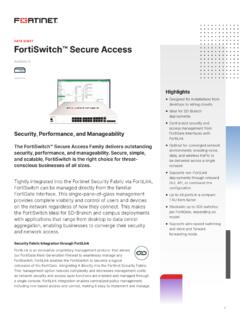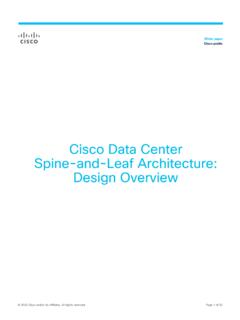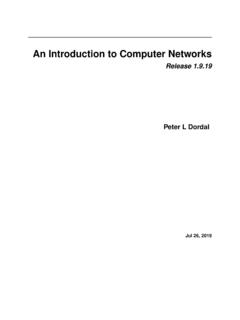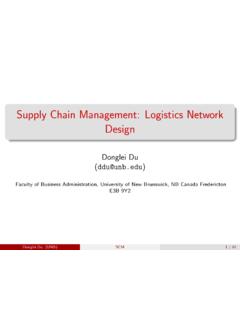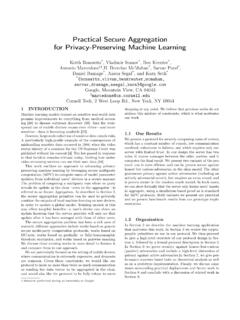Transcription of M -S C A D C - arXiv
1 Published as a conference paper at ICLR 2016. M ULTI -S CALE C ONTEXT aggregation BY. D ILATED C ONVOLUTIONS. Fisher Yu Princeton University Vladlen Koltun Intel Labs [ ] 30 Apr 2016. A BSTRACT. State-of-the-art models for semantic segmentation are based on adaptations of convolutional networks that had originally been designed for image classifica- tion. However, dense prediction problems such as semantic segmentation are structurally different from image classification. In this work, we develop a new convolutional network module that is specifically designed for dense prediction. The presented module uses dilated convolutions to systematically aggregate multi - scale contextual information without losing resolution. The architecture is based on the fact that dilated convolutions support exponential expansion of the receptive field without loss of resolution or coverage. We show that the presented context module increases the accuracy of state-of-the-art semantic segmentation systems.
2 In addition, we examine the adaptation of image classification networks to dense prediction and show that simplifying the adapted network can increase accuracy. 1 I NTRODUCTION. Many natural problems in computer vision are instances of dense prediction. The goal is to com- pute a discrete or continuous label for each pixel in the image. A prominent example is semantic segmentation, which calls for classifying each pixel into one of a given set of categories (He et al., 2004; Shotton et al., 2009; Kohli et al., 2009; Kr ahenb uhl & Koltun, 2011). Semantic segmenta- tion is challenging because it requires combining pixel-level accuracy with multi - scale contextual reasoning (He et al., 2004; Galleguillos & Belongie, 2010). Significant accuracy gains in semantic segmentation have recently been obtained through the use of convolutional networks (LeCun et al., 1989) trained by backpropagation (Rumelhart et al., 1986).
3 Specifically, Long et al. (2015) showed that convolutional network architectures that had originally been developed for image classification can be successfully repurposed for dense prediction. These reporposed networks substantially outperform the prior state of the art on challenging semantic seg- mentation benchmarks. This prompts new questions motivated by the structural differences between image classification and dense prediction. Which aspects of the repurposed networks are truly nec- essary and which reduce accuracy when operated densely? Can dedicated modules designed specif- ically for dense prediction improve accuracy further? Modern image classification networks integrate multi - scale contextual information via succes- sive pooling and subsampling layers that reduce resolution until a global prediction is obtained (Krizhevsky et al., 2012; Simonyan & Zisserman, 2015). In contrast, dense prediction calls for multi - scale contextual reasoning in combination with full-resolution output.
4 Recent work has studied two approaches to dealing with the conflicting demands of multi - scale reasoning and full-resolution dense prediction. One approach involves repeated up-convolutions that aim to recover lost resolu- tion while carrying over the global perspective from downsampled layers (Noh et al., 2015; Fischer et al., 2015). This leaves open the question of whether severe intermediate downsampling was truly necessary. Another approach involves providing multiple rescaled versions of the image as input to the network and combining the predictions obtained for these multiple inputs (Farabet et al., 2013;. Lin et al., 2015; Chen et al., 2015b). Again, it is not clear whether separate analysis of rescaled input images is truly necessary. 1. Published as a conference paper at ICLR 2016. In this work, we develop a convolutional network module that aggregates multi - scale contextual information without losing resolution or analyzing rescaled images.
5 The module can be plugged into existing architectures at any resolution. Unlike pyramid-shaped architectures carried over from image classification, the presented context module is designed specifically for dense prediction. It is a rectangular prism of convolutional layers, with no pooling or subsampling. The module is based on dilated convolutions, which support exponential expansion of the receptive field without loss of resolution or coverage. As part of this work, we also re-examine the performance of repurposed image classification net- works on semantic segmentation. The performance of the core prediction modules can be uninten- tionally obscured by increasingly elaborate systems that involve structured prediction, multi -column architectures, multiple training datasets, and other augmentations. We therefore examine the leading adaptations of deep image classification networks in a controlled setting and remove vestigial com- ponents that hinder dense prediction performance.
6 The result is an initial prediction module that is both simpler and more accurate than prior adaptations. Using the simplified prediction module, we evaluate the presented context network through con- trolled experiments on the Pascal VOC 2012 dataset (Everingham et al., 2010). The experiments demonstrate that plugging the context module into existing semantic segmentation architectures re- liably increases their accuracy. 2 D ILATED C ONVOLUTIONS. Let F : Z2 R be a discrete function. Let r = [ r, r]2 Z2 and let k : r R be a discrete filter of size (2r + 1)2 . The discrete convolution operator can be defined as X. (F k)(p) = F (s) k(t). (1). s+t=p We now generalize this operator. Let l be a dilation factor and let l be defined as X. (F l k)(p) = F (s) k(t). (2). s+lt=p We will refer to l as a dilated convolution or an l- dilated convolution. The familiar discrete convo- lution is simply the 1- dilated convolution.
7 The dilated convolution operator has been referred to in the past as convolution with a dilated filter . It plays a key role in the algorithme a` trous, an algorithm for wavelet decomposition (Holschneider et al., 1987; Shensa, 1992).1 We use the term dilated convolution instead of convolution with a dilated filter to clarify that no dilated filter is constructed or represented. The convolution opera- tor itself is modified to use the filter parameters in a different way. The dilated convolution operator can apply the same filter at different ranges using different dilation factors. Our definition reflects the proper implementation of the dilated convolution operator, which does not involve construction of dilated filters. In recent work on convolutional networks for semantic segmentation, Long et al. (2015) analyzed filter dilation but chose not to use it. Chen et al. (2015a) used dilation to simplify the architec- ture of Long et al.
8 (2015). In contrast, we develop a new convolutional network architecture that systematically uses dilated convolutions for multi - scale context aggregation . Our architecture is motivated by the fact that dilated convolutions support exponentially expanding receptive fields without losing resolution or coverage. Let F0 , F1 , .. , Fn 1 : Z2 R be discrete functions and let k0 , k1 , .. , kn 2 : 1 R be discrete 3 3 filters. Consider applying the filters with exponentially increasing dilation: Fi+1 = Fi 2i ki for i = 0, 1, .. , n 2. (3). Define the receptive field of an element p in Fi+1 as the set of elements in F0 that modify the value of Fi+1 (p). Let the size of the receptive field of p in Fi+1 be the number of these elements. It is 1. Some recent work mistakenly referred to the dilated convolution operator itself as the algorithme a` trous. This is incorrect. The algorithme a` trous applies a filter at multiple scales to produce a signal decomposition.
9 The algorithm uses dilated convolutions, but is not equivalent to the dilated convolution operator itself. 2. Published as a conference paper at ICLR 2016. (a) (b) (c). Figure 1: Systematic dilation supports exponential expansion of the receptive field without loss of resolution or coverage. (a) F1 is produced from F0 by a 1- dilated convolution; each element in F1. has a receptive field of 3 3. (b) F2 is produced from F1 by a 2- dilated convolution; each element in F2 has a receptive field of 7 7. (c) F3 is produced from F2 by a 4- dilated convolution; each element in F3 has a receptive field of 15 15. The number of parameters associated with each layer is identical. The receptive field grows exponentially while the number of parameters grows linearly. easy to see that the size of the receptive field of each element in Fi+1 is (2i+2 1) (2i+2 1). The receptive field is a square of exponentially increasing size.
10 This is illustrated in Figure 1. 3 M ULTI -S CALE C ONTEXT aggregation . The context module is designed to increase the performance of dense prediction architectures by aggregating multi - scale contextual information. The module takes C feature maps as input and produces C feature maps as output. The input and output have the same form, thus the module can be plugged into existing dense prediction architectures. We begin by describing a basic form of the context module. In this basic form, each layer has C. channels. The representation in each layer is the same and could be used to directly obtain a dense per-class prediction, although the feature maps are not normalized and no loss is defined inside the module. Intuitively, the module can increase the accuracy of the feature maps by passing them through multiple layers that expose contextual information. The basic context module has 7 layers that apply 3 3 convolutions with different dilation factors.
![arXiv:0706.3639v1 [cs.AI] 25 Jun 2007](/cache/preview/4/1/3/9/3/1/4/b/thumb-4139314b93ef86b7b4c2d05ebcc88e46.jpg)

![arXiv:1301.3781v3 [cs.CL] 7 Sep 2013](/cache/preview/4/d/5/0/4/3/4/0/thumb-4d504340120163c0bdf3f4678d8d217f.jpg)
![@google.com arXiv:1609.03499v2 [cs.SD] 19 Sep 2016](/cache/preview/c/3/4/9/4/6/9/b/thumb-c349469b499107d21e221f2ac908f8b2.jpg)






